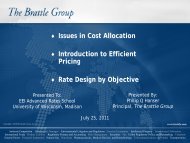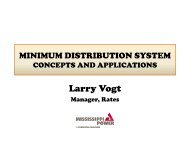Bob Hemphill, Consultant (for Peter Mayer)
Bob Hemphill, Consultant (for Peter Mayer)
Bob Hemphill, Consultant (for Peter Mayer)
Create successful ePaper yourself
Turn your PDF publications into a flip-book with our unique Google optimized e-Paper software.
Residential Hot Water<br />
Consumption Trends<br />
<strong>Peter</strong> <strong>Mayer</strong><br />
Vice President and Project Engineer<br />
2709 Pine St.<br />
Boulder, CO 80302<br />
www.aquacraft.com<br />
1
Residential Hot Water Research<br />
• Important area of research with limited<br />
current data available<br />
• Hot water is 2nd largest portion of<br />
residential energy consumption in US<br />
• 2 EPA studies (2000 - 2003) conducted by<br />
Aquacraft<br />
• Forthcoming ASHRAE Research Project<br />
establishing “protocol” <strong>for</strong> residential hot<br />
water demand measurements
Crosscutting Trends<br />
• Is residential hot water use likely to change?<br />
– YES…BUT it could go up or down<br />
• Trends favoring decrease<br />
– Efficient plumbing fixtures and appliances<br />
• Trends favoring increase<br />
– Changes in home building practices, larger bath<br />
tubs, new devices that use hot water
EPA/Aquacraft Hot Water Research<br />
• 2 study sites - Seattle, WA and East Bay<br />
Municipal Utility District (Greater Oakland,<br />
CA)<br />
• Hot water demand research part of water<br />
efficient product retrofit studies<br />
• 10 homes were studies in each study site.<br />
Overall, n=20.
Research Methodology<br />
• Study group selection (modified random sample)<br />
• Site audits<br />
• Installation of water meter on in-flow to hot<br />
water heater<br />
• Flow data loggers installed on main meter and<br />
hot water meter<br />
• 2-weeks of baseline flow data (10-second<br />
intervals) prior to retrofits<br />
• 4-weeks of post-retrofit flow data
Meter-Master Flow Data Recorder
Data Analysis Methods<br />
• Flow trace data were analyzed using Trace<br />
Wizard © water use analysis software<br />
• Water used <strong>for</strong> each specific end use was<br />
determined<br />
• Paired t-test analyses were used to evaluate the<br />
demands <strong>for</strong> each end use measured at the study<br />
homes in the pre and post-retrofit periods
Trace Wizard Water Use Analysis Tool<br />
Main meter flow trace<br />
Hot water meter flow trace
Residential Water Use - Baseline<br />
Hot water<br />
40%<br />
(25.1 gcd)<br />
Hot water<br />
30%<br />
(21.1 gcd)<br />
Cold water<br />
60%<br />
(37.1 gcd)<br />
Average Daily Per Capita Use - Baseline = 62.2 gcd<br />
Cold water<br />
70%<br />
(49.8 gcd)<br />
Average Daily Per Capita Use - Baseline = 70.9 gcd<br />
Seattle, Washington<br />
Oakland, Cali<strong>for</strong>nia
Baseline Hot Water Use - By End Use<br />
Seattle<br />
Oakland<br />
Hot (gcd) Cold (gcd) Hot (gcd) Cold (gcd)<br />
Bath 4.2 5.3 1.7 1.9<br />
Clothes washer 3.9 14.1 1.9 12.4<br />
Dishwasher 0.9 0.9 1.4 1.4<br />
Faucet 8.6 11.9 8.6 13.2<br />
Leak 1.2 4.4 0.7 11.2<br />
Shower 6.3 8.7 6.9 9.6<br />
Other 0.01 0.02 0.02 0.03<br />
TOTAL 25.1 62.2 21.1 70.9
Retrofit of Efficient Fixtures and<br />
Appliances
Post-Retrofit Hot Water Use<br />
Seattle<br />
Oakland<br />
Baseline<br />
(gcd)<br />
Post-Retrofit<br />
(gcd)<br />
Baseline<br />
(gcd)<br />
Post-Retrofit<br />
(gcd)<br />
Bath 4.2 2.5 1.7 1.5<br />
Clothes w a sher 3.9 1.5 1.9 1<br />
Dishw a sher 0.9 1 1.4 1<br />
Faucet 8.6 7.7 8.6 6.2<br />
Leak 1.2 0.8 0.7 0.7<br />
Shower 6.3 7 6.9 6<br />
Other 0.01 0.01 0.02 0.01<br />
TOTAL 25.1 20.5 21.1 16.5
ASHRAE Research<br />
• American Society of Heating, Refrigerating and Air-<br />
Conditioning Engineers<br />
• Metering Residential Hot Water by End-Use -<br />
Development of Standard Protocol<br />
• Dept. of Architecture, University of Nebraska, Lincoln<br />
• Developed complex field protocol including temperature<br />
and water use monitoring<br />
• Simpler, less expensive data collection approach may be<br />
desirable<br />
• Limited data collection ef<strong>for</strong>t - researchers hope to expand<br />
ef<strong>for</strong>t in near future
Trends Suggesting Increasing<br />
HW Demand - 1<br />
Floor Area of New Privately Owned Single Family<br />
Dwellings by Year of Construction<br />
Source: US Census Bureau
Trends Suggesting Increasing<br />
HW Demand - 2<br />
• Increasing number of stories per house<br />
• Increasing number of bathrooms per house<br />
• Increase floor area per house<br />
• Jacuzzi tubs and other new fixtures
Conclusions<br />
• Cross-cutting trends in residential hot water<br />
use exist<br />
• Plumbing codes and efficient fixtures likely<br />
to decrease HW demand in older housing<br />
stock<br />
• Building trends in new houses suggests<br />
potential <strong>for</strong> increased demand<br />
• Important area <strong>for</strong> future research
For more in<strong>for</strong>mation…..<br />
www.aquacraft.com - download reports, demo<br />
software, etc.<br />
mayer@aquacraft.com<br />
2709 Pine St.<br />
Boulder, CO 80302<br />
303-786-9691<br />
303-786-8337 (fax)


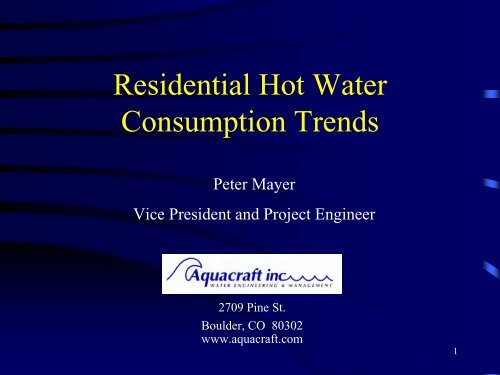
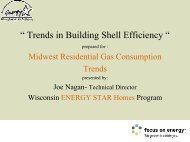

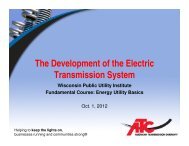

![[Hybrid Synergy Drive Knowledge is Power]](https://img.yumpu.com/35232059/1/190x143/hybrid-synergy-drive-knowledge-is-power.jpg?quality=85)
